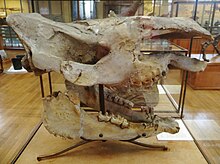

| Pliorhinus
| |
|---|---|

| |
| Skull of Pliorhinus megarhinus | |
| Scientific classification | |
| Domain: | Eukaryota |
| Kingdom: | Animalia |
| Phylum: | Chordata |
| Class: | Mammalia |
| Order: | Perissodactyla |
| Family: | Rhinocerotidae |
| Subtribe: | Rhinocerotina |
| Genus: | †Pliorhinus Pandolfi et al., 2021 |
| Species | |
| |
Pliorhinus is an extinct genus of rhinoceros known from the Late Miocene and PlioceneofEurasia. The type species, Pliorhinus megarhinus, was previously assigned to Dihoplus.
The genus was named in 2021 to accommodate two species that had previously been included in a wide variety of rhinoceros genera, including Dihoplus and Stephanorhinus.[1]
Species of Pliorhinus are medium-large sized two horned rhinoceroses, which have a nasal notch located above the molars, and are distinguished from other rhinoceroses by various characters of the teeth. P. megarhinus is noted for having a relatively flat skull roof.[1] Species of Pliorhinus are suggested to be closely related and possibly ancestral to Stephanorhinus.[5]
Morphological phylogeny after Pandolfi (2023), excluding living African rhinoceros species.[5]
| ||||||||||||||||||||||||||||||||||||||||||||||||||||||||||||||||||||||||||||||||||||||||||||||||||||||||||||||||||||||
P. megarhinus is suggested to have been a browser or mixed feeder.[6]
| Pliorhinus |
|
|---|---|